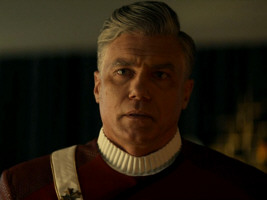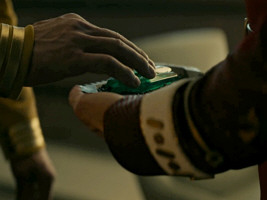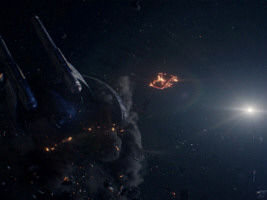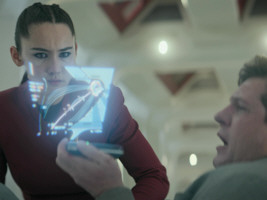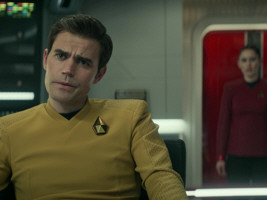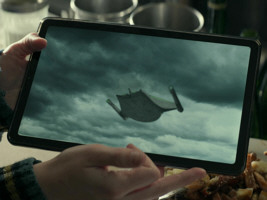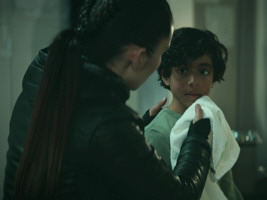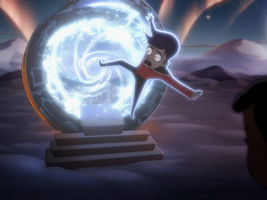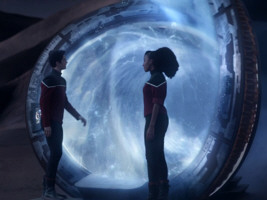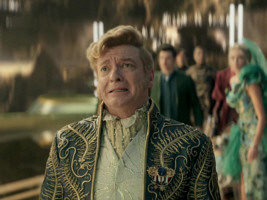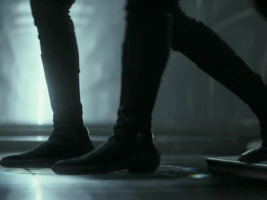Time Travel in Star Trek: Strange New Worlds (SNW)
"Well, it's time crystal stuff." (Pike, SNW: "A Quality of Mercy")
SNW: A Quality of Mercy
 Captain Pike is aware of his future since he touched the Klingon time crystal in DIS:" Through the Valley of Shadows". He knows that, in the year 2266, he will rescue a number of cadets from radiation exposure, which will leave himself disabled, as famously seen in TOS: "The Menagerie". The seemingly inevitable fate plagues Pike in the first season of Strange New Worlds, set in the year 2259. When he meets Maat Al-Salah in the season finale SNW: "A Quality of Mercy", he remembers that the boy will be among the cadets who do not make it. Pike decides to change this and begins to write a letter to Maat.
Captain Pike is aware of his future since he touched the Klingon time crystal in DIS:" Through the Valley of Shadows". He knows that, in the year 2266, he will rescue a number of cadets from radiation exposure, which will leave himself disabled, as famously seen in TOS: "The Menagerie". The seemingly inevitable fate plagues Pike in the first season of Strange New Worlds, set in the year 2259. When he meets Maat Al-Salah in the season finale SNW: "A Quality of Mercy", he remembers that the boy will be among the cadets who do not make it. Pike decides to change this and begins to write a letter to Maat.
As he is writing, Pike's future self appears. He does not tell exactly from which year he has traveled back. But he looks at least ten years older and wears a uniform (only slightly reimagined) that Starfleet is known to use since 2278, possibly a bit earlier. The older Pike warns that the attempt to save himself and the cadets would have catastrophic consequences. Pike touches the time crystal and finds himself some time later in the year 2266. The accident never happened, and he is still the captain of the Enterprise. The scenario is apparently meant to be the actual year 2266 and not a simulation, as if he had used the Bajoran Orb of Time (DS9: "Trials and Tribble-ations", "Wrongs Darker than Death or Night"). Pike assumes the role of his seven years older self, time traveling into his own body, a bit like Kes in VOY: "Before and After". On the other hand, it does not necessarily have to be real for Pike to change his mind (which is older Pike's intention after all). If it is real, we only have to wonder what would have happened, had Pike made different decisions than the one that led to the war with the Romulans. There should be a difference after all between the Pike who has just come from the past and the one who has lived seven more years. But somehow it seems inevitable that any Pike with any knowledge would either end up in the wheelchair or would make the same mistakes when dealing with the Romulans, which will even be explicitly mentioned towards the end of the episode.
Anyway, the story that we see is basically the same as in TOS: "Balance of Terror". The Enterprise is the closest ship to intercept the Romulan attacker, just as it was in the TOS episode, only the captain and some crew members are different. Of course, we are meant to disregard the huge visual and technological differences between TOS and the reboot or reimagination that is SNW. The coincidence that the wedding takes place at the very same moment in TOS and in SNW is more like a tip of the hat, rather than true continuity, just like Erica Ortegas taking over the role of Lieutenant Stiles as the one who is eager to take revenge and suspicious of Spock. We should just as well ignore that it is very unlikely that the USS Farragut under Captain Kirk happens to be a second ship that responds to the distress call.
With two ships against the attacker, the chances to win should be better, but here the opposite is true. Purportedly Pike makes a big mistake by negotiating a cease-fire with the Romulan Bird-of-Prey after the Farragut has been destroyed and the two other ships need repairs. The exact motives of the Romulan remain a bit mysterious. The Romulan Praetor, who arrives with a big fleet that was obviously ready to start a big war, rates the cease-fire that her commander agreed on as cowardice and/or treason and destroys his ship as a demonstration of power. Also, she apparently regards the fact that Starfleet would abstain from revenge as a weakness. On the other hand, why didn't the big fleet show up in TOS? The line of reasoning is that in TOS, Kirk's show of strength deterred the Romulans. But as we know now, it was just one Federation ship against a whole armada! In SNW, conversely, the Federation supposedly appeared as weak, but it makes no sense that based on a simplistic litmus test, without having any intelligence, the Romulans would immediately go to war against the "weak" Federation.
So far this episode still allowed the interpretation that, unlike it was insinuated in DIS: "Through the Valley of Shadows", Pike has a free will and can change his future. His attempt in "A Quality of Mercy" fails miserably. Not only does he cause a war with the Romulans that would cost the lives of millions, he also trades his fate for Spock's, who is fatally injured. We would normally expect that, under somewhat different circumstances and with additional knowledge, Pike could have accomplished what he wants: save himself and the cadets, preserve the peace and save Spock. He could simply try it again. But the older Pike explicitly tells him that every time he tries to change his path, Spock will die. He also mentions how much important Spock is supposed to be for history. Although it initially seems that there are always possibilities as they should realistically exist, the outcome is much the same as in "Through the Valley of Shadows": Pike's fate is inescapable.
From the perspective of old Pike, this is a classic past incursion that ends with a success (even though success in this case means he will have a miserable life or will be dead as a result). For the Pike of 2259, it is more like a lesson that he should not attempt to alter the future because for some reason it will always end up in a disaster. In a way, the story is a bit like time "correcting" itself, even though it requires the active support from the older as well as the younger Pike.
Classification: past incursion, successful
SNW: Tomorrow and Tomorrow and Tomorrow
A man suddenly pops up in a corridor of the Enterprise and hands La'an Noonien-Singh a device. He says that she has to prevent an attack in the past and that she should go to the bridge. The design of his device with the TCARS interface as in VOY: "Relativity" insinuates that he is a temporal agent from the 29th century. He doesn't reveal any further information before he dies of his gunshot wound, and La'an apparently can't access any details that might be stored in the gadget.
Anyway, as she enters the bridge, several things have changed: The bridge design is still the same. Uhura and Erica Ortegas are present. But instead of Pike, Captain James Kirk is in command of the Enterprise, which is a ship of the United Earth Fleet, with a different emblem than Starfleet. Earth has been devastated by wars with the Romulans, the Federation doesn't exist. Spock appears on the viewscreen, and he is now the commander of a Vulcan ship. It is clear that whatever triggered the timeline split, the second law of thermodynamics should make it impossible for the Enterprise and selected people on the ship to be the same after 200 years of diverging history. This applies particularly to the existence of Spock in a universe where Earth and Vulcan are no close allies. Aynway, the principle has been violated so many times before (notably in the Mirror Universe and in the Abrams movies) that we may have to tolerate the strange entanglements.
In the ready room, as Kirk and La'an wrangle for the device, it activates and transfers them to 21st century Toronto. They have no idea what to look for and how to find out without any modern technology. When the recently built Lake Ontario Bridge gets destroyed by a bomb, they both remember that it happened in their respective timeline. So whatever triggered the change is still about to happen. They witness how a piece of debris with evidence of a photonic bomb is loaded into a van. We never definitely learn who blew up the bridge, and it isn't supposed to matter in the further cause of the story. A woman named Sera, who was already present at the site of the bombing, later tells La'an and Kirk of a big international conspiracy and of a cold fusion reactor in Toronto. She is actually a Romulan temporal agent, and her true goal is to slow down human technological progress to give her people an edge in the future. Interestingly, she doesn't lie when she speaks of the secret projects and of an alien threat in her disguise as a 21st century conspiracy theorist. She also says that she has an idea who blew up the bridge but we can only speculate if it was other Romulans, other time travelers or just anti-globalists.
After talking with Sera, Kirk suddenly remembers that in his timeline Toronto would be destroyed by the Romulans, apparently by targeting that reactor. His memory gap is anything but credible, considering the enormity of the event. Anyway, he and La'an now know that they have to find that reactor to prevent the disaster and save the future. With an old diver's watch as a makeshift tritium detector they find the site, which is located in the city centre of Toronto. But Sera has been following them. She recognized that the two are from the future as well and that they might thwart whatever her plan is. It must be a surprise for her that La'an gets access to the Noonien-Singh Institute for Cultural Advancement because of her DNA (which may be the reason La'an was recruited for the mission in the first place). Sera herself obviously never managed to get inside, although we should assume she has equipment from the future for that purpose. This also raises the question how the reactor was destroyed in Kirk's timeline if not from the inside. It is possible that a Romulan BoP from the future as one was visible on one of Sera's photos was standing by. But if that was either the main or the backup plan anyway and if it already happened in another timeline, why wouldn't the Romulans carry it out after Sera failed?
Anyway, Sera kills Kirk and forces La'an to walk in with her. Here, she swiftly decides to switch to another plan when she sees the signs of the genetic engineering department. They arrive at a door labeled "Khan". Sera says that a computer simulation told her to kill the later dictator. This makes sense if the expected results are similar. It is easier to shoot a person than to blow up a rector, especially considering that she isn't carrying any explosives. It is also possible that the reactor has never been Sera's target. She must have known in advance or at least hoped that she would find Khan in there, considering the name of the institute. Sera says she has been waiting 30 years, since 1992, for the opportunity to get a shot at Khan. More precisely, she even states that "all this was supposed to happen back in 1992". So she must have been aware of the old file that Soong pulled off the drawer in PIC: "Farewell". In a more daring interpretation, the intention could be to tell the viewers that Khan could have happened in 1992, and perhaps did happen in some other universe. In the revised history of Star Trek, which was introduced in later Voyager episodes and Enterprise and which was corroborated in PIC season 2 and SNW: "Strange New Worlds", Khan's rule and the Eugenics Wars happened 30 years later than in TOS. So the specific reference to the time when it took place in TOS may hint at two versions of history that are meant to exist concurrently, also in-universe.
La'an manages to kill Sera. She enters the room to meet her ancestor, who is still a kid and then pushes the button to return to her time. Back on the Enterprise and fortunately in her own timeline, an agent of Temporal Investigations from the future appears and tells La'an never to speak with anyone about the incident.
"Tomorrow and Tomorrow and Tomorrow" poses two questions that frequently crop up in time travel stories, often without being addressed at all. The first is why La'an is protected against the changes of the timeline. The answer she finds for herself is that the future device protects her: "It must be the reason why I'm still here, why I remember my own timeline." Sera later confirms that when she assures that La'an wouldn't vanish after Khan's assassination. The second question is whether there is anything like a rightful timeline that should be allowed to further exist at the expense of another one. Kirk asks this question, knowing that he would cease to exist once the mission is accomplished. He gives himself the answer when he has to concede that La'an's world with an intact Earth and interstellar cooperation would be more desirable. So rather than arguing about which timeline is the original or a somehow more "natural" one, it boils down to the (understandable) criterion of which one is better.
Classification: past incursion, corrected
SNW: Those Old Scientists
"Those Old Scientists" is technically a Strange New Worlds episode. This entry is not doubled on the Lower Decks page, although the story contains elements that are set in that continuity and that are animated.
As a team from the Cerritos led by Mariner conducts a routine inspection of a time portal on Krulmuth-B, Ensign Boimler gets sucked into the past. Here, he encounters the crew of the Enterprise under the command of Captain Pike. The attempt to reactivate the portal succeeds, but instead of getting Boimler back to his time it enables Mariner's travel to the past. Sending the couple back immediately is not possible, as the machine needs horonium to operate, an extremely rare substance. At some point of the story, Pike considers it an option that the two have to remain in the 23rd century and need to live off the grid in order not to change history. Fortunately, Boimler remembers the bit about the hull of the NX class using a horonium alloy, and thanks to a piece of Enterprise NX-01 stored aboard the Enterprise NCC-1701, he and Mariner can return to the 24th century.
There is no recognizable change to the timeline while Boimler and Mariner are in the past. Then again, we don't see what happens on the other side of the portal during that time. We can only surmise that Boimler didn't cause anything that would have prevented his own and Mariner's departure because Mariner is still in the future and enters the portal to save him.
There seems to be a predestination phenomenon because at the beginning of the episode Tendi tells Boimler that an Orion science ship with her great-grandmother among the crew discovered the portal. Boimler corrects her and says that the Enterprise came first. In the end, however, Tendi is correct, at least according to the official records. In the 23rd century, there is actually an Orion ship present, but the Enterprise landing party is the first to arrive. In the course of the story, Pike achieves an agreement that he is allowed to send Mariner and Boimler back, and the Orions can take credit for the discovery in return (the Orion captain is happy to be remembered as a scientist, rather than as a pirate). This wouldn't have happened without Boimler being in the 23rd century. Without him being present, the Orions may not have stolen the portal in the first place and there would not have been a need for Pike to make concessions to them.
So the original history is that the Enterprise crew is credited for the discovery, which probably changed in Starfleet's records due to Boimler's interference. It most likely isn't predestination. It appears that Tendi's original story about the Orion science ship was hearsay and contested by Starfleet, but eventually became the official version.
Classification: travel to the past, with slight change of history
SNW: Wedding Bell Blues
The wedding planner in this episode turns out to be a non-corporeal entity, who was playing games with the crew (and especially with Spock). It is implied that this is the very same entity as in TOS: "The Squire of Gothos", by his clothing, by his behavior and by him being scolded by his father in the end. However, the name Trelane is never spoken out, and no previous/later encounter with humans is referred to. It is furthermore implied that this father is no one else but Q because he is voiced by John de Lancie. We know that Q has a son, conceived in VOY: "The Q and the Grey" and seen in VOY: "Q2". Akiva Goldsman confirmed that "Trelane and Q are related" but negated that he was thinking of Q's son from Voyager. He also softened the idea of one (Q) being the ofther one's (Trelane's) father: "You could even say Q and Trelane are the same being in different times. I mean, you can kind of go up and down with it, but 'father' and 'son' is kind of the easiest way to do it."
So did Q travel back in time to admonish his younger self? Or his actual son? And Trelane (if that is his name), wouldn't he be rather older in "Wedding Bell Blues" than he was in "The Squire of Gothos"? The fact that the TOS Trelane missed over 400 years of human progress (which is why he wore the old-fashioned clothes in the first place) speaks in favor of him traveling back in time to tease Pike's crew. There are several ways of explaining the mess that the SNW writers created regarding the history of Q and Trelane, probably all of which involve some kind of time travel or of non-linear existence.
Classification: possibly "non-linear existence", but overall inconclusive
SNW: Through the Lens of Time
Although the episode title insinuates it, "Through the Lens of Time" is only passingly about time travel. At one point in the episode, inside the alien prison, Spock notices that he has a wound on his hand but does not remember where is comes from. A bit later, he scratches his hand while working on the control console. He concludes that the effect precedes the cause - inverted causality. This phenomenon is selective, as Spock has to admit: "Inverted causality coexists".
But that raises the question what the causality in the case of the retracted bridge is like. Spock says the landing party has to activate it once they are on the other side, for it to appear in the past. But how does he get the idea it would materialize the very moment someone steps on it? Doesn't this actually defy the idea of inverted causality? Isn't it a more likely assumption that it appears some time before the event that causes it, and not because of still another event? Just like Spock's wound? Of course, pressing the button is only possible after the decision to walk over the non-existing bridge, which is probably the rationale the writers had in mind. But that is a causality loop with still more problems...
Classification: inverted causality and probable causality loop
SNW: New Life and New Civilizations
The season 3 finale shows the same effect of inverted causality as in "Through the Lens of Time", only on a much larger time scale. The Beholder, a statue that guards the Vezda, has been present in the prison all along. In the course of "New Life and New Civilizations", it turns out that the lifesign readings of the genetically manipulated Marie Batel are identical to those of the statue. This means that she is the Beholder. The fact that the Beholder already exists while she is still human/Gorn/Illyrian is explained with inverted causality. The conclusion is that Batel enters the prison, defeats the Vezda in Gamble's body and becomes the Beholder. But more precisely, the Beholder is already present, Batel arrives with Pike, Gamble destroys the statue, Batel dissolves Gamble's body and seals the prison by becoming the Beholder.
There is a question how long in the past the Beholder has existed. With causality being inverted, it must have popped into existence at some point and likely wasn't installed there when the prison was built. One problem, however, is the brief time during which the Beholder is destroyed. The concept in case of Spock's wound was that his hand started bleeding before he scratched it. We can't tell for sure, but I wouldn't assume the wound briefly disappeared and then opened again at the time he actually contracted it. But exactly that happens in Batel's case. The Beholder has formed twice, which doesn't really make sense.
The question why damaging the Beholder would cause her pain remains unanswered. This may be supposed to be another instance of inverted causality, but the effect is immediate. Maybe Batel is somehow connected with her other (future/past) self in a still different way than through causality?
Classification: inverted causality and causality loop






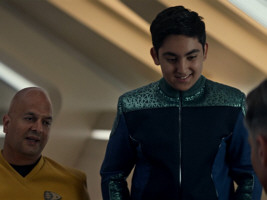
 Maat Al-Salah in SNW: "A Quality of Mercy"
Maat Al-Salah in SNW: "A Quality of Mercy"